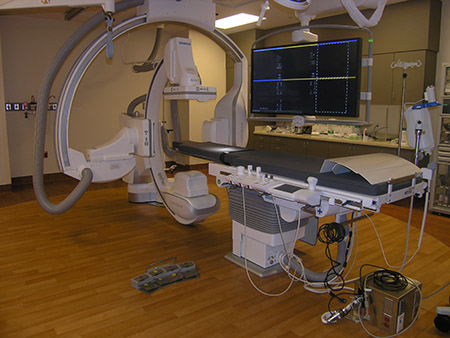
When a stroke strikes, time matters. Restoring normal blood flow quickly saves brain cells and brain function. New technology at Baylor Regional Medical Center at Plano provides patients with faster access to a range of treatment options.
In July, Baylor Plano opened its newly renovated neurointerventional radiology suite. The $2 million renovation added significantly more advanced technology that gives physicians the ability to obtain 3-D images and take multiple views of the brain at the same time.
"This technology gives doctors more information and the ability to treat a wider spectrum of critical neurological illnesses," says Justin Whisenant, MD, a neurointerventional radiologist on the medical staff at Baylor Plano.
Neurointerventional radiology can offer a less invasive alternative to traditional surgical therapy for people with brain aneurysms, strokes, some tumors and many other brain and spinal vascular conditions.
The devices and imaging equipment allow neurointerventional radiologists to access the small blood vessels in the brain by passing catheters through the large vessels in the thigh. Imaging and accessing the brain in this way are new treatment options.
"With these expanded treatment methods available, patients will experience faster recovery times and shorter hospital stays, and can expect to resume their usual activities more quickly than with open surgical options," he says.
Less- invasive devices include stents, balloons and coils that can be used to treat stroke, brain aneurysms and circulatory system defects in the brain.
For example, stroke patients who don't respond to the clot-busting medication called tPA can have stents or balloons threaded to the spot in the brain where the clot is causing a blockage. The clot is removed and the stroke symptoms go away. Doctors choose a retrievable stent, a balloon or a suction tube based on each patient's needs.
For people with bleeding in the brain, coils can stop the bleeding. The coils are threaded to the site of the bleeding, where they trigger clotting. Having these treatments available at Baylor Plano means patients can be cared for quickly, and in new and innovative ways.
"This technology is widely available for use in the heart and body, but less common in the brain because the brain is so much smaller and less forgiving," Dr. Whisenant says.
Some conditions still require traditional surgery, and the Baylor Plano team ientifies the best option for each patient.
# # #
MEDIA CONTACT:
Jennifer McDowell
Jennifer.McDowell@baylorhealth.edu
office: (214) 820-4581
About Baylor Scott & White Health
As the largest not-for-profit health system in the state of Texas, Baylor Scott & White promotes the health and well-being of every individual, family and community it serves. It is committed to making quality care more accessible, convenient and affordable through its integrated delivery network, which includes the Baylor Scott & White Health Plan, Baylor Scott & White Research Institute, the Baylor Scott & White Quality Alliance and its leading digital health platform – MyBSWHealth. Through 51 hospitals and more than 1,200 access points, including flagship academic medical centers in Dallas, Fort Worth and Temple, the system offers the full continuum of care, from primary to award-winning specialty care. Founded as a Christian ministry of healing more than a century ago, Baylor Scott & White today serves more than three million Texans. For more information, visit: BSWHealth.com

